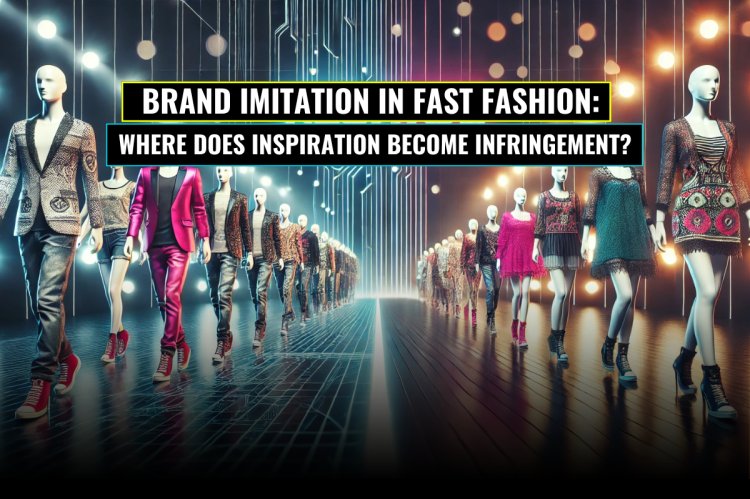Brand Imitation in Fast Fashion: Where Does Inspiration Become Infringement?
Fast fashion brands have redefined the fashion industry by making luxury-inspired designs accessible to the mass market. However, this often leads to accusations of imitation and intellectual property (IP) infringement. While some argue that these brands merely draw inspiration from high-end designers, others see it as outright copying that undermines creativity and brand value. This blog explores the legal, ethical, and economic implications of brand imitation in fashion, highlighting key legal cases and potential solutions for protecting original designs.

Introduction
The rise of fast fashion has revolutionized the accessibility of high-fashion trends. Retailers like Zara, Shein, and H&M replicate runway designs at an unprecedented pace, offering consumers affordable alternatives. However, this accessibility often comes at the cost of legal disputes with luxury brands that claim their designs have been copied without permission. The challenge lies in defining the boundary between inspiration and infringement. This article examines the fine line between creative influence and intellectual property violations.
Understanding Fashion Imitation
Fast fashion thrives on quick replication of luxury designs, often walking a thin line between legal and illegal imitation. Many of these brands produce garments that closely resemble those of luxury houses such as Gucci, Chanel, and Balenciaga. The affordability and rapid turnaround raise concerns about whether these designs constitute unauthorized reproduction or mere inspiration.
Key Factors Driving Fast Fashion Imitation
- Speed & Trend Responsiveness – Fast fashion brands aim to capitalize on trends as quickly as possible, reducing production cycles from months to just weeks.
- Lack of Design Protection – Unlike other creative industries, fashion design is difficult to patent or copyright, leaving loopholes for imitation.
- Consumer Demand for Affordable Luxury – Many consumers desire high-end fashion aesthetics at lower prices, incentivizing fast fashion retailers to recreate designer looks.
Legal Aspect: IP Protection in Fashion
Unlike industries like music or film, fashion has limited legal safeguards against imitation. However, several IP laws attempt to regulate brand imitation:
1. Trademark Law
- Protects logos, brand names, and distinctive symbols.
- Example: Burberry’s check pattern is trademarked to prevent unauthorized use.
2. Design Patents
- Covers novel, non-functional design elements.
- Challenges: Expensive and time-consuming process.
- Example: Christian Louboutin’s red sole is legally protected as a design feature.
3. Trade Dress Protection
- Protects the overall look and feel of a product if it is distinctive and widely recognized.
- Example: Gucci’s stripe pattern is a recognizable trade dress.
Case Studies of Brand Imitation
1. Gucci vs. Forever 21
Gucci sued Forever 21 for copying its iconic stripe pattern, arguing that it led to brand dilution and consumer confusion. The dispute was eventually settled out of court.
2. Christian Louboutin vs. Mr. Pawan Kumar & Ors.
Christian Louboutin took legal action against manufacturers producing red-soled shoes similar to their trademarked design. The court ruled in favor of Louboutin, awarding punitive damages for trademark infringement.
To know more about this you can follwo the link below:
3. Adidas vs. Skechers
Adidas successfully secured a preliminary injunction against Skechers for copying its signature sneaker design, demonstrating how courts often side with established brands in IP disputes.
4. Ritika Private Limited vs. Biba Apparels Private Limited
The court ruled that once a design is mass-produced over 50 times, it loses copyright protection unless specifically registered under the Designs Act. This ruling highlights the legal ambiguity surrounding fashion design protection.
The fast fashion industry often thrives in these legal grey areas, allowing brands to imitate trends without fully infringing on IP laws.
Economic Impact
- Luxury brands: Lose exclusivity, potentially reducing their prestige and profitability.
- Consumers: Gain access to affordable fashion but contribute to the devaluation of original designs.
- Ethical concerns: Many fast fashion brands rely on exploitative labor practices and mass production that may compromise quality and sustainability.
Strategies for Luxury Brands to Protect Their Designs
- Strengthening Trademark & Trade Dress Protections – Ensuring brand signatures, like patterns and logos, are legally safeguarded.
- Lobbying for Stronger Design Protection Laws – Advocating for IP laws that cater specifically to fashion.
- Innovative Branding & Limited Editions – Producing exclusive collections that are harder to replicate.
- Collaborating with Fast Fashion Brands – Engaging in high-low collaborations (e.g., H&M x Balmain) to retain creative control.
- Technology-Based Solutions – Utilizing blockchain and digital authentication to prevent counterfeiting.
Conclusion
The intersection of fashion, law, and ethics continues to evolve as fast fashion brands push the boundaries of imitation. While luxury brands must develop innovative strategies to protect their intellectual property, legislators must also consider stronger protections for fashion designs. At the same time, maintaining a balance between accessibility and originality is essential for fostering creativity in the fashion industry. Ultimately, the question remains: How can we encourage inspiration without crossing the line into infringement?












